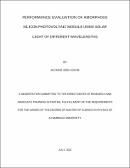Performance evaluation of amorphous silicon photovoltaic module using solar light of different wavelengths
Abstract
The performance of amorphous silicon photovoltaic module was evaluated using solar light of
different wavelengths in this study. The different wavelengths of solar light were filtered by use
of colour filters. During data collection, the plane of the module was oriented perpendicular to the
sun, in order to ensure that module gets the maximum irradiation. The I-V tracer was
employed to obtain the module I-V curves, P-V curves and subsequently the I-V outputs of the
module. The short circuit current and power output of the module varied at different wavelengths
of solar light, but the module’s open circuit voltage was almost constant at different wavelengths.
The highest short circuit current of 0.76 A, maximal power of 9.60 W and efficiency of 3.60 %
were obtained when the module was not covered with any colour filter. Among all the used colour
filters, the yellow colour of solar light gave the highest short circuit current of 0.68 A, maximal
power of 8.89 W and efficiency of 3.29 %. This suggests that the yellow light is highly efficient
in the amorphous silicon photovoltaic module power generation compared to the other colours of
the visible light. The impact of module temperature on the module’s open circuit voltage and short
circuit current for different wavelengths of solar light were also investigated. The results showed
that the rise in module temperature led to the fall in the open circuit voltage and small increment
in short circuit current of the module regardless the wavelength of solar light. Due to the outcomes
of this research, it was recommended that more research is needed to be done by filtering solar
light into single wavelengths rather than the band of wavelengths. The colors of visible light
which were not considered in this study, have to be considered for future work. Manufacturers
may use the findings of this study to modify the technological design of the module so as efficiently
capture the wavelengths of solar light within the yellow portion of the visible spectrum.

